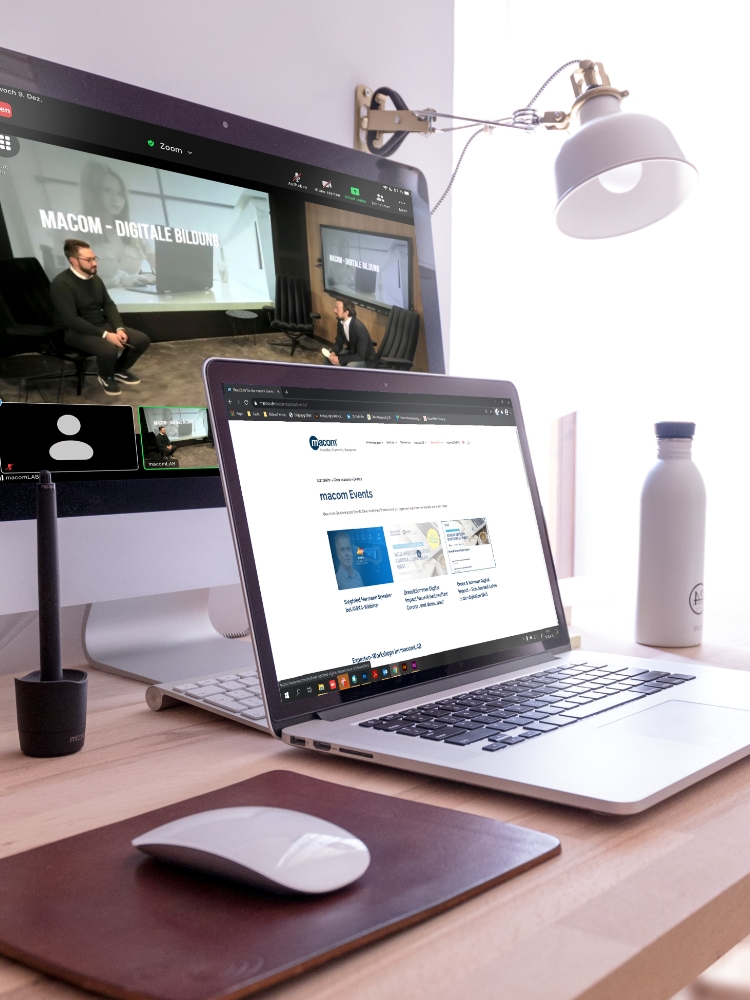The term “hybrid learning” refers to a mixture of digital and face-to-face teaching. Participants connect simultaneously from any location to a face-to-face lecture in a lecture hall.
Especially during the last months of the pandemic, this format has increasingly emerged as a possible option for teaching events. Holding events with large numbers of participants in full seminar rooms or lecture halls has been and continues to be difficult. Even regardless of this, hybrid settings offer advantages: they grant students more flexibility in how they learn. People who, for various reasons, cannot be on site at the appropriate time now nevertheless have an opportunity to participate in various courses. Digital applications such as video conferencing and collaboration tools enable rapid exchange across distances, interactive collaboration and a form of face-to-face contact.
On the other hand, the simultaneity or synchronicity in the hybrid setting increases the complexity and requirements for all participants and differs in this respect from “blended learning” – the alternation of purely online and face-to-face phases.
Teachers, students and those responsible for technology face new organizational, technical and didactic challenges in hybrid learning. The premises and equipment of the universities must be adapted to the new conditions. Teaching methods are also changing as a result of the new formats.
The central goal here is to provide an equivalent learning experience for all students. After all, remote participants still have disadvantages in the hybrid setting. They are forgotten or cannot participate sufficiently. With appropriate concepts and the right technology, the different conditions for remote and face-to-face participants can be harmonized.
Possible scenarios for instructional design
Depending on the situation, instructional design requires different technical requirements for implementing new teaching formats. Factors to be considered include the type and location of the event, the number of participants and the degree of interaction between the participants.
Comparatively easy to implement is an asynchronous, i.e., non-hybrid, form of teaching. Students who do not attend the event on site are provided with the event content via an online portal for independent processing. This can be done through a recording of the event or just by providing a script.
It becomes more difficult when remote participants and students in the room are to be taught simultaneously; i.e., hybrid. For example, a lecture can be made available to a large number of participants via live broadcast of the presentation. Using a UC platform, the lecturer shares the presentation on his computer with the connected students. They can dial in either from home or from other rooms on the campus. They receive the lecturer’s presentation via a high-quality microphone in the lecture hall.
In this constellation, the remote participants only see the presentation and not the lecture hall. Interaction is thus limited. Remote students can, for example, ask questions about the content via an integrated chat function. Audio playback in the room via voice chat would also be conceivable. However, this means additional work for the teaching staff. Chat processes have to be moderated and remote participants have to be actively involved in order to take part in what is happening. This may require the support of another person to take over this task. In order to hear students’ requests to speak in the auditorium, it requires additional miking of all seats in the auditorium, which may also be somewhat of a technical challenge depending on the size.
Another possibility would be to use a camera integrated in the lecture hall to film the presentation. A beamer can be used to project the presentation onto a large wall.
For largely one-way courses, such a setting may be sufficient. In a seminar that aims at cooperation between groups, other aspects need to be considered.
For interactive teaching sessions or group discussions, it is especially important to create the right conditions to reach all students. With special cameras and sufficient microphones in the room, the participants at the computer can get a better impression of the situation on site and follow the course of the event better. Of course, they should also have appropriate headsets and cameras on their terminals so that they, in turn, can be heard and seen. Well-regulated moderation of the groups is again indispensable.
The integration of other (analog) media in the room, such as a blackboard or flipchart, can be done through an extra camera that the instructor can switch to when needed. Specific ways of assigning tasks and roles when working with remote participants can also help eliminate problems. In a discussion session, remote participants can specifically act as observers and then provide critical feedback.
To further reduce the boundary with the presence participants, another approach is to have all participants present on site also connected to the web conference on their end device. This means that they can easily enter into a conversation directly with the remote participants or work together on the digital whiteboard.
Hybrid and modern university: macom makes it possible

For learning and teaching in a modern environment, we need to sensitize everyone involved to how changing circumstances and needs affect the delivery of teaching formats.
Digital technologies have great potential to support these processes. However, the digitization of teaching will only succeed if technical applications are also integrated into the curriculum in a way that makes sense from a didactic point of view and are tailored to user needs. From the necessary infrastructure (Internet connections, WLAN with appropriate bandwidth) to lecture hall technology and mobile end devices: intuitive usability and long-term operational reliability are crucial for the constructive use of technology and a productive teaching and learning experience.
We advise universities on their digital strategy, create individual technology concepts for the respective use cases and develop sustainable operating concepts for a smooth start to the semester and beyond.
Author: Felix Niedrich, Editor macom GmbH
